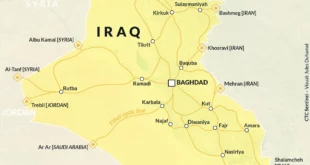A parked car bomb killed 25 people and wounded 115 when it exploded near an intersection in central Baghdad on Thursday and police said the toll could rise as many bodies were believed still buried under rubble.Bodies lay strewn around the street after the blast, which smashed three buildings into piles of masonry and concrete. It was at least the fourth to hit the predominantly Shiite district of Karrada this week.
US and Iraqi forces have stepped up security operations in Baghdad since mid-February in an attempt to stem bombings, many of them blamed on Al Qaeda in Iraq, a Sunni Islamist group that US officials say is trying to spark a full-scale civil war.
But large-scale bombings continue to plague the capital.
US President George W. Bush, under mounting pressure from opposition Democrats to set a timetable for withdrawing American troops, has sent 28,000 more soldiers to Iraq this year, bringing the total force to about 157,000.
While the build-up only peaked in June, the Pentagon is making contingency plans for a withdrawal, according to US Defence Secretary Robert Gates.
In a letter delivered on Tuesday to Senator Hillary Clinton, a New York Democrat and presidential candidate who tangled with the Pentagon to learn whether such plans exist, Gates said he was actively involved in drafting them.
“You may rest assured that such planning is indeed taking place with my active involvement as well as that of senior military and civilian officials and our commanders in the field,” Gates said in the letter obtained by Reuters.
“I consider this contingency planning to be a priority for this department.” A critical juncture in the war is likely to be in September, when Bush’s top officials in Iraq present a report to the US Congress on Iraq’s security and political progress.
With little sign of political reconciliation between majority Shiites and once dominant minority Sunni Arabs, the report could heighten calls for US troops to pull out.
In Baghdad’s Karrada district, residents bundled victims from the car bomb into the boots of cars and the back of pick-up trucks and vans to rush them to hospital as police tried to evacuate stunned residents.
At least one building and several cars were ablaze and a huge plum of thick black smoke rose into the air. Short bursts of gunfire could be heard soon after the explosion.
Karrada, normally one of Baghdad’s most stable areas, was hit by three separate blasts on Monday, which killed 13 people.
Separately, the US military said six soldiers had been killed in Iraq over the past two days.
Three Marines and a soldier died in combat in volatile Diyala province north of Baghdad on Tuesday. A roadside bomb killed a soldier in Baghdad on the same day, while another soldier was killed by small arms fire in Baghdad on Wednesday.
On Thursday, the US military’s second most senior commander in Iraq said militia mortar and rocket crews had been hitting Baghdad’s heavily protected Green Zone with greater accuracy in the past three months because of training from Iran.
Lieutenant-General Raymond Odierno’s comments came after the US ambassador to Iraq accused Tehran of increasing support for militias when he met his Iranian counterpart for a second round of talks on Iraq’s violence on Tuesday.
Iran rejects the allegations.
“In the last three months we have seen a significant improvement in the capability of mortarmen and rocketeers to provide accurate fire into the Green Zone and other places,” Odierno, operational commander of US forces in Iraq, said.
“We think this is directly related to training conducted inside Iran,” he told a news conference.
Rocket and mortar barrages have hit the sprawling Green Zone, home to the US embassy and Iraqi government buildings, with greater frequency in recent months.
 Eurasia Press & News
Eurasia Press & News


